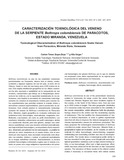Mostrar el registro sencillo del ítem
Caracterización Toxinologica del veneno de la serpiente bothrops colombiensis de paracotos, Estado Miranda, Venezuela
| dc.rights.license | http://creativecommons.org/licenses/by-nc-sa/3.0/ve/ | |
| dc.contributor.author | Duque Zerpa, Carmen Teresa | |
| dc.contributor.author | Vargas, Alba M. | |
| dc.date.accessioned | 2015-07-06T20:13:06Z | |
| dc.date.available | 2015-07-06T20:13:06Z | |
| dc.date.issued | 2015 | |
| dc.identifier.uri | http://www.saber.ula.ve/handle/123456789/40549 | |
| dc.description.abstract | Bothrops colombiensis es una de las serpientes venenosas predominantes en Venezuela, abarca todo el oriente, centro, occidente y algunas regiones del sur del país, al norte del río Orinoco, desde el nivel del mar hasta unos 2.500 metros de al- tura. Esta amplia distribución geográfica en los ofidios venenosos ha sido asociada a variabilidad en la composición de sus venenos, característica que influye en la fisiopatología observada en las víctimas y en la capacidad neutralizante de los antivenenos, esto implica la necesidad de caracterizar toxicológicamente los venenos de importancia médica para colectar datos experimentales que permitan mejorar el manejo clínico y seleccionar venenos representativos para la producción de antivenenos. Este estudio planteó la caracterización toxinológicamente del veneno de Bothrops colombiensis de Paracotos (Edo. Miranda), región geográfica no evaluada, estimando sus actividades letal, hemorrágica, edematizante, coagulante, des- fibrinante y necrosante, así como su perfil electroforético. Los resultados obtenidos evidenciaron un perfil toxinológico similar a lo usualmente descrito para este género, aunque con variaciones cuantitativas como una elevada actividad edematizante, una baja actividad hemorrágica y un importante efecto neurotóxico, observado por primera vez en esta especie. La posible in- cidencia de estos resultados en el cuadro clínico, tras el accidente por esta especie, hace necesario documentar esta situación con estudios clínicos y evaluar el potencial neutralizante de la terapia antiofídica existente. Adicionalmente, la escasa actividad hemorrágica evidenciada sugiere que el veneno evaluado no posee una carga antigénica representativa del potencial hemorrágico del género Bothrops, por lo que no debería ser empleado como único representante de su especie para la producción de antivenenos en Venezuela. | es_VE |
| dc.rights | info:eu-repo/semantics/openAccess | |
| dc.subject | Bothrops colombiensis | es_VE |
| dc.subject | Caracterización toxinológica | es_VE |
| dc.subject | Hemorragia | es_VE |
| dc.subject | Efecto neurotóxico | es_VE |
| dc.title | Caracterización Toxinologica del veneno de la serpiente bothrops colombiensis de paracotos, Estado Miranda, Venezuela | es_VE |
| dc.title.alternative | Toxinological Characterization of Bothrops colombiensis Snake Venom from Paracotos, Miranda State, Venezuela | es_VE |
| dc.type | info:eu-repo/semantics/article | |
| dc.description.abstract1 | Bothrops colombiensis is one of the predominant venomous snakes in Venezuela; its range covers the whole Eastern, Central and Western Regions and some Southern regions of the country, to the North of the Orinoco river, from sea level up to 2500 meters in height. This wide geographic distribution of a venomous snake has been associated to the variability of the venom composition, which influences both the physiopathology observed in the victims and the neutralizing capacity of antivenoms. This fact justifies the characterization of venoms of medical importance, in order to gather experimental data that will allow to improve the clinical management and to choose representative venoms for antivenom production. This study proposed the toxinological characterization of Bothrops colombiensis snake venom from Paracotos, Miranda State, ageographical region not evaluated, as for venoms, in order to estimate it’s lethal, hemorrhagic, edemaforming, coagulant, defibrinating and necrotizing activities and also its electrophoretic profile. The results show a toxinological profile similar to the one described for this genus, even though with some highlighted quantitative variations such as high edema-forming activity, a low hemorrhagic effect and a high neurotoxic effect, which has been observed for the first time on this Venezuelan species. The relevance of these results in the clinical context makes it necessary to document these with clinical studies and the evaluation of the neutralizing capacity of the antivenom. In addition, the scarce hemorrhagic activity suggests that the evaluated venom does not seem to have an antigenic charge which properly represents the hemorrhagic potential of Bothrops genus and it should not be used alone for the antivenom production in Venezuela. | es_VE |
| dc.description.colacion | 239-247 | es_VE |
| dc.description.email | ctduque@gmail.com | es_VE |
| dc.publisher.pais | Venezuela | es_VE |
| dc.subject.institucion | Universidad del Zulia (LUZ) | es_VE |
| dc.subject.institucion | Universidad de Los Andes (ULA) | es_VE |
| dc.subject.keywords | Bothrops colombiensis | es_VE |
| dc.subject.keywords | Toxinological characterization | es_VE |
| dc.subject.keywords | Hemorrhage | es_VE |
| dc.subject.keywords | Neurotoxic effect | es_VE |
| dc.subject.publicacionelectronica | Revista Científica | |
| dc.subject.seccion | Revista Científica: | es_VE |
| dc.subject.thematiccategory | Medio Ambiente | es_VE |
| dc.subject.tipo | Revistas | es_VE |
| dc.type.media | Texto | es_VE |
Ficheros en el ítem
Este ítem aparece en la(s) siguiente(s) colección(ones)
-
Revista Científica - 2015 - Vol. XXV- No. 003
Mayo - Junio 2015


